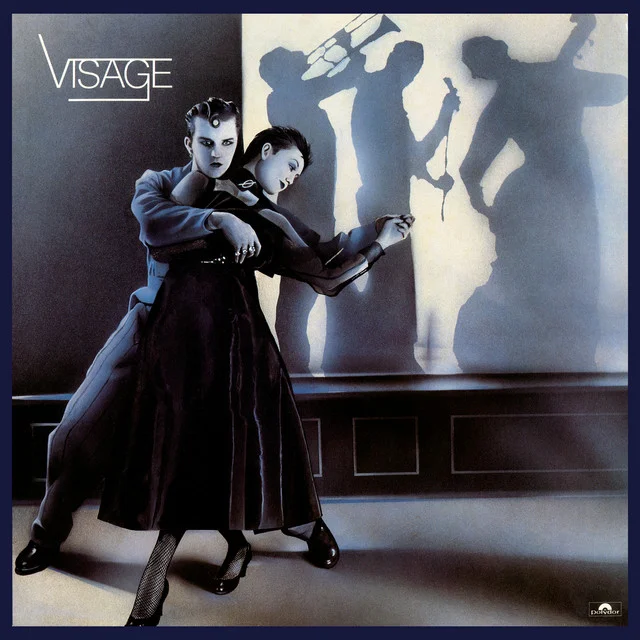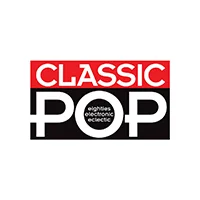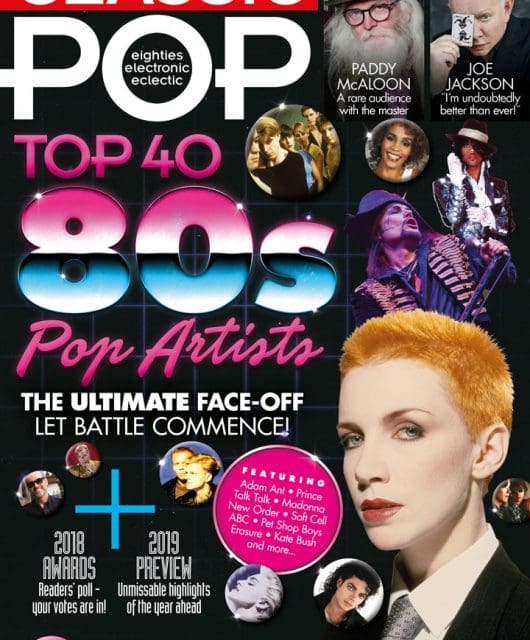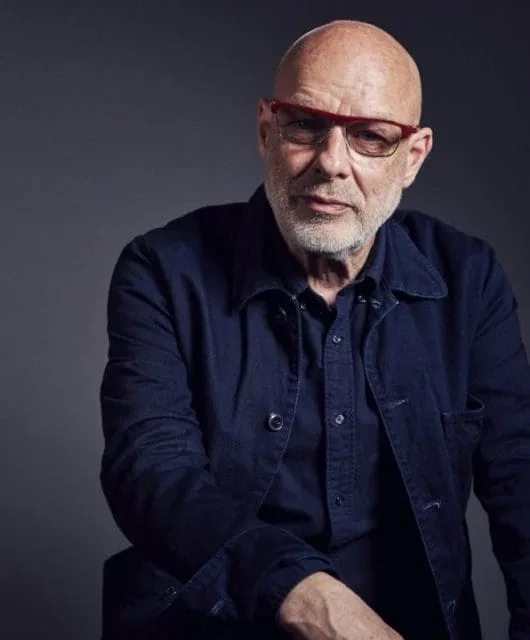Making Visage: Visage
By Classic Pop | July 19, 2021
Where would the New Romantic movement have been without Visage… or vice versa? The band’s self-titled debut album was the result of an almost supergroup-like meeting of talented individuals.
Aiming to forge a new brand of electro-disco via chilly, bombastic synths and glam rock guitars, they drew upon everything from European film noir to spaghetti westerns and cossack choirs… By Andy Jones

We now look back at Visage, the band, as some kind of 80s supergroup, because so many of the musicians involved in it later went off to enjoy huge success in other projects. Guitarist Midge Ure and keyboardist Billy Currie, of course, later joined forces to rejuvenate Ultravox; Rusty Egan and Steve Strange notoriously invented clubland, and bassist Barry Adamson went on to become a successful musician, writer and filmmaker.
However, at the time, Visage was really the coming together of a loose collective of musicians, all dabbling in at least one other project, seemingly waiting for one of them to be successful. And when they came together, that success certainly happened in the form of Visage: the founding stars of the New Romantic movement would produce an album from that scene, for that scene and to announce that scene to the whole world.
In 1978, one of the three founding members of Visage, Midge Ure, was between successful bands. He’d enjoyed big hits with Slik and Vienna was to come later, but back then he was playing and locking horns with Glen Matlock in The Rich Kids – an act Matlock had set up after being thrown out of the Sex Pistols.
Rusty Egan was in the band as well, and siding with Midge over wanting to take the band in a more electronic direction. Steve Strange, meanwhile, had done his best to become a face in the London punk scene while fast becoming the face of a new scene, but was singing with a short-lived band called The Photons.
It was this band’s final showcase gig that led Ure and Egan to invite Strange along to record in some studio sessions at Manchester Square Studios, using some studio time owed to them by The Rich Kids’ record company.
The trio looked around at some of the other bands who were producing the forward-thinking synth music that was inspiring both Midge and Rusty, and invited two members of Magazine to join the sessions: keyboard player Dave Formula and bass player Barry Adamson.
While in The Rich Kids, Egan and Ure had already bought themselves a synth and a drum machine and had started work on some music together, and some of these tracks were recorded in these early sessions including two covers – Zager and Evans’ In the Year 2525 and Barry McGuire’s Eve Of Destruction – plus the instrumental track The Dancer. The demos were done; now all they needed was a name.
“I came up with the name of Visage,” Steve Strange claimed in his autobiography, Blitzed. “‘Vis’ stood for the visual elements of the band, ‘Visa’ represented the fact that we were going to be a global band, and ‘age’ symbolised our part in the new age of music.”
Read more: Rusty Egan interview
The demos were put aside for a while as Strange and Egan began putting on the infamous Bowie nights which led to the Blitz club forming, and Midge joined Thin Lizzy to help out after the departure of guitarist Gary Moore.
In 1979, however, Egan, Ure and Strange reconvened, determined to capitalise on the demos that they had recorded which were going down well with the New Romantic clubbers at Blitz. With Billy Currie joining Dave Formula on keyboards, guitarist John McGeoch joining from Magazine, Adamson on bass, Midge on guitar, Rusty on drums and Strange on vocals, the classic Visage lineup was born, with Rusty’s enthusiasm very much the driving force behind them all.
“I always knew that Midge Ure, Billy Currie, John McGeoch, Barry Adamson and Dave Formula were amazing talents, and that one day everyone else would know it too,” he told thisisnotretro.com in 2010. “I also thought Steve Strange was a kind of Pied Piper front man, not really a great singer but that was not as important as his presence.”
With Rusty very much seeing himself as the band’s director, he came up with many of the song ideas including Block On Blocks (inspired by a visit to the Berlin wall) and the closing and more ambiently-styled track The Steps. “I imposed the rule that ‘it’s either ambient or you can dance to it’, and the band would just do it – amazing, really!”
Early tracks were recorded with the producer Martin Rushent. He was a firm believer in both Visage the band and Visage the upcoming album, and at the time he was busily constructing his own Genetic Sound studio, in which he would later go on to record the Human League’s huge album Dare.
“I remember going to his studio just outside of Reading, which wasn’t quite finished at the time,” Strange recalled of the recordings. “It didn’t look like anything more than a shed in a rather large garden, yet some fabulous music came out of it, and not just ours.”
Thanks to Martin’s burgeoning studio and Midge and Rusty’s equipment, they had access to pretty much the best that studio technology offered at the time. “We used everything on that album,” Rusty told Sean Rothman in Electronic Soundmaker & Computer Music in 1984. “We had a Yamaha GS2, two Yamaha grands, two ARP Odyssey synths, about three Yamaha string synths, a CS80 [Yamaha synth] and a Minimoog [synth].” To top off that impressive list the band also had the run of a Fairlight, a hugely expensive and now-classic early sampler – in fact, it was the first one ever to be used in the UK.
Read more: Spandau Ballet – Journeys To Glory
Read more: Making Duran Duran
“The Fairlight required the programming expertise of producer Richard James Burgess and was used heavily on the track Fade To Grey. Burgess, incidentally, was one of the members of the band Landscape, who recorded Einstein A Go-Go, and later went on to produce Spandau Ballet’s first two albums. The band therefore had the influence, the technology, the looks and now the sound to make the most New Romantic recording ever.
Steve was relatively new to singing but as the more experienced vocalist, Midge would help him out during the recordings. “Midge would be very strict with me,” Strange recalled. “If I was off-key or got the wrong notes, I would have to do it over and over again. But I didn’t mind because we were all trying to make the best album.”
As the album progressed further, Rusty decided that the feel of the whole recording should resemble one of his DJ sets at the Blitz club, so set about redirecting the project’s pace and flow.
“I wanted our album to be non-stop with one track leading into the next,” he reflects. “I was trying to make music to play in my club, and I wanted to make music that was influenced by Kraftwerk and the Yellow Magic Orchestra.
“It signifies the set I was playing at Blitz. These days, people are interested in music from anywhere in the world, but in those days it had to come from England or the States. Music from Sweden, Germany and Japan was considered to be laughable. We changed all that. We loved Europe, hence the track Visa-Age. It’s why Fade To Grey had the girl singing in French.”
Richard Burgess produced some of the instrumental links to help tracks blend together, and ‘the girl singing in French’ was Rusty’s then-girlfriend Brigitte Arens.
After successfully recording much of the album at Martin Rushent’s studio, the band had to then complete it with a finance deal with Morris O’Donnel Productions. Rusty explained the deal to Electronic Soundmaker & Computer Music: “Visage, the original idea, was made by musicians as a studio situation, so we did a deal with a studio. It happened to be Martin Rushent’s studio [at one point, there was a chance that the LP would appear on Genetic]. That’s where the first Visage album was born and it was completed and mixed for Morris O’Donnel Productions, who in turn were the management of Ultravox.
“A production company takes a royalty, like a producer. Morris O’Donnel said ‘We’ll pay for you to finish the album’, that was all, the songs were already there.”
Some of this decision appears to have been made in the light of the fact that Tar, the first single, was released through Rushent’s Genetic Records label via Radar Records, but it failed to make an impact. So, with the album complete in 1979, the band decided they needed a new deal and better distribution than Genetic could offer, so eventually signed to Polydor.
However, this meant that there was a year between Tar being released and the next single, Fade To Grey, which came out in November 1980. They therefore needed to make an impact, and because videos were just taking off at the time, it was decided that one for Fade To Grey was essential; it would showcase not only the song but also Steve Strange’s incredible looks, which were becoming so central to the New Romantic movement.
“With the directors Kevin Godley and Lol Creme, I came up with a storyline for the video,” Steve said in Blitzed. “My eyebrow turned into a snake, then my arms became a snake, the snake bit me and I died and faded to grey.”
The investment in the video – one of the first-ever Godley and Creme productions – paid off handsomely, propelling Fade To Grey to Top 10 chart positions across the world. Follow-up singles Mind Of A Toy and Visage (that’s Visage the single, by Visage the band, taken from Visage the album) helped the album shift in numbers.
It sold well in Europe, striking gold in Germany with over a quarter of a million sales. With the same line-up, the follow up album The Anvil was also successful, but it was the debut album Visage that captured the zeitgeist of New Romanticism. As Egan said, it was essentially a playlist from the Blitz club, played for its members and by its members; 10 tracks to take you back to the club that started it all.
Visage: Visage – The Songs
Visage
The intro to Visage’s debut introduces the band and their manifesto – “new styles, new shapes, new modes”. Lyrically, there’s not a massive amount else to be had here – we’ve already given you about 30% of them – and synths and sequences tend to carry much of the melodies and choruses, although there is a big rock undercurrent that acts as a fine counter to all the electronics. It’s a now familiar combination; this Midge Ure/Billy Currie mix of driving guitar and synths would go onto be the hallmark of their work with the second incarnation of Ultravox.
Blocks On Blocks
It’s a track that tests Strange’s newfound vocal talents to the maximum. He doesn’t always pass with flying colours, and thankfully there’s a vocoder to help out in the chorus, and a great synth solo/breakdown diverts any attention. Blocks On Blocks is actually a pretty decent track although you do already start to wonder who came up with the track list for the album; as strong as these openers are, they’re not up there with the belters that feature later. Good job people had much longer attention spans back in the 80s.
The Dancer
The Dancer was one of the first Visage songs recorded at those Manchester Square Studio sessions. It could be straight off any later Ultravox b-side – again featuring those string synths and rock guitars – although there’s a bit of Bowie-like arranging in there. What it doesn’t have are any Strange vocals, as it’s one of the album’s instrumentals.
Tar
This was Visage’s first single on Genetic Records and, again, you wonder why they didn’t just opt for Fade To Grey. Where that track has fancy French singing, this all about… smoking. Even putting the lyrics aside, the 80s sax solos, splodgy synths and pianos plus the thought of nicotine stains on your dad’s fingernails will send you packing. It’s not a track that has aged like a fine wine, but the next sounds like a fine Château Lafite Rothschild Pauillac in comparison.
Fade To Grey
Finally! The song that made Visage and Steve Strange is still remarkably fresh-sounding – and a guaranteed floor-filler. Maybe it’s because its synth sounds have regularly swung back into vogue, or it might be those sophisticated French bits (‘devenir gris’ unsurprisingly means ‘Fade To Grey’). Or perhaps it’s just a bloody good song that, sadly, Steve didn’t write and remained very bitter about in later years (not surprising given its worldwide success and enduring appeal – 20 million plays on YouTube and counting). It did propel him to great heights though, as it did the actual writers. Chris Payne went off to play keys with Gary Numan, and of course Midge Ure and Billy Currie then smashed it as part of Ultravox.
Malpaso Man
Not the first track on Visage or by Visage to have a theme; this time it’s cowboys in an album highlight that drives and tries hard as the opening track of side B. There are whip-cracks, twangy guitars and then, unexpectedly, a couple of fine synth solos that knock you sideways away from the frantic Western themes.
Mind Of A Toy
Easily the second-best track on Visage – not a bad honour given the first is Fade To Grey. Mind Of A Toy is both eerie and catchy. It kicks off with barely a beat, bass and voice, a scary, almost Theremin-like synth whistle blowing it all together. But what really stands out, in a ‘is it genius or rubbish?’ kind of way, is the constant double-tracking on certain words; ‘nothing’ and ‘can’t’, in the first verse, for example, and ‘when’, ‘toy’, ‘me’ in the chorus. It’s either a brilliantly-clever thematic link, with a hidden message on control and manipulation, or someone just accidentally did it in the studio and it sounded good. We’re probably edging towards the latter, if we’re honest…
Moon Over Moscow
Another themed track with hints of Russian folk melodies and singing, plus the now familiar entwined Visage beasts of guitar and synths. Throw in that vocoder again and you’ll wonder a) how someone came up with such a ridiculous combination of ingredients for a song, then b) who decided to record them and c) how such a ridiculous combination actually ended up sounding pretty good.
Visa-age
See what they did there. Visa-age is about travel (and presumably how to pay for it) and a new age of music. We’d have said that this was single material, possibly along with Malpaso Man, but then we’d have completely rearranged the track order of the album too, so what do we know?
The Steps
We close with another instrumental track, but this time one that could have been lifted straight from A Clockwork Orange or any of those 70s sci-fi films starring Chuck Heston. As the album closes, you wonder if Visage was really just intended as a vehicle to showpiece Midge, Billy et al’s talents, but one that was then hijacked by Strange and driven in a completely different visual direction. Whatever, the winning combination of those musicians and Strange would never be bettered, and The Steps is a dramatic end title for a bombastic debut… and Visage’s finest work.
Check out Visage’s official website
Read our 2019 interview with Gary Numan






